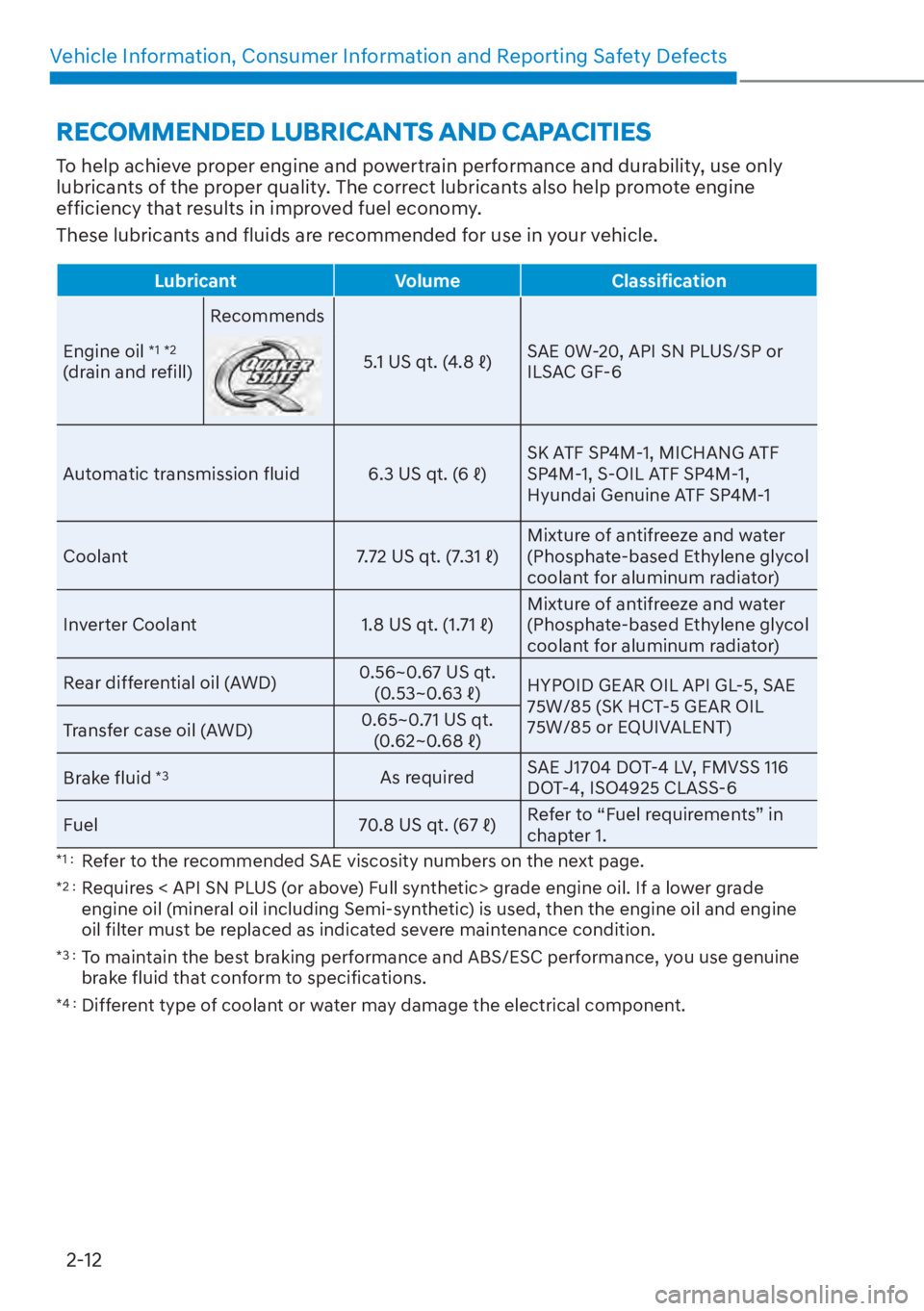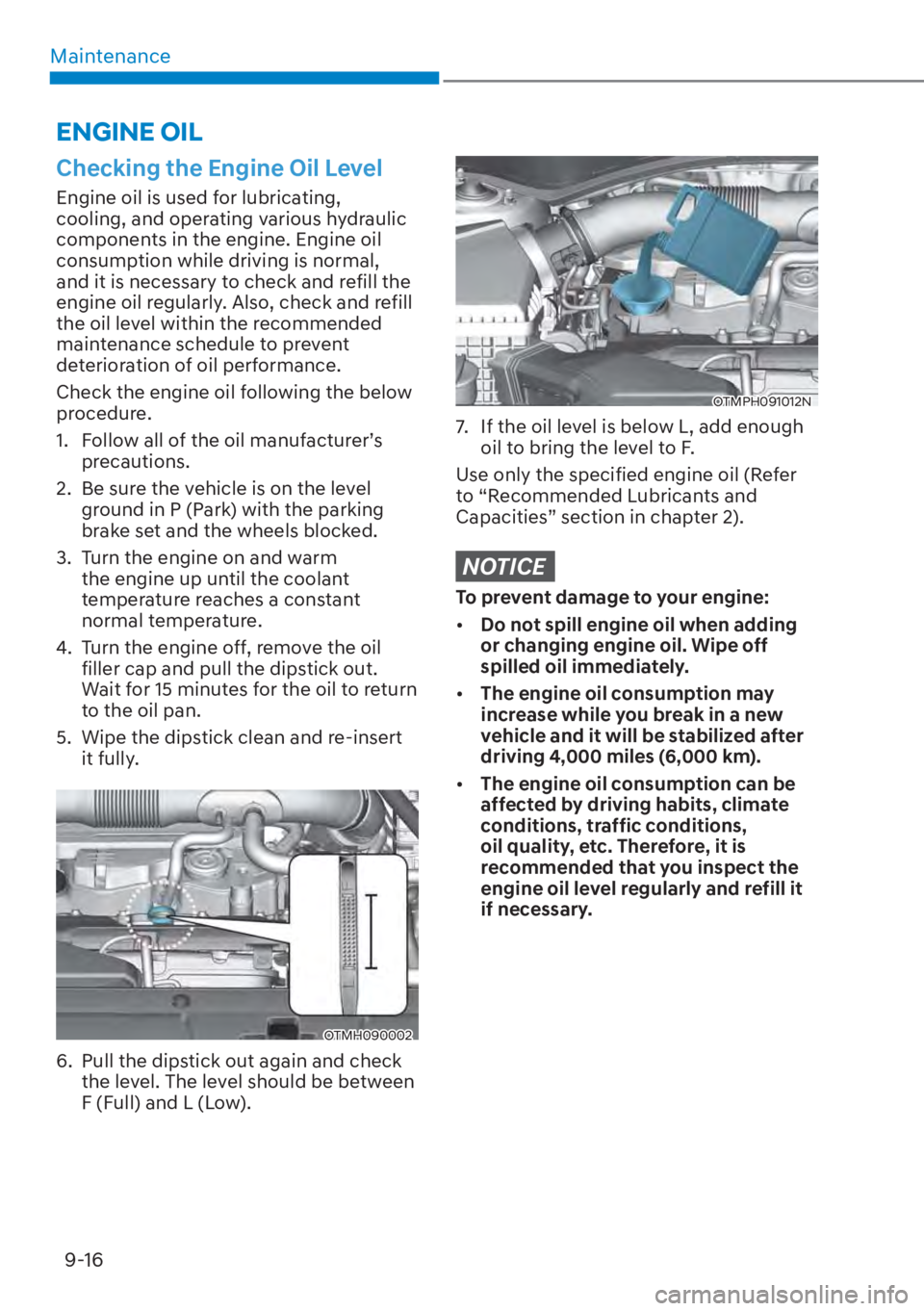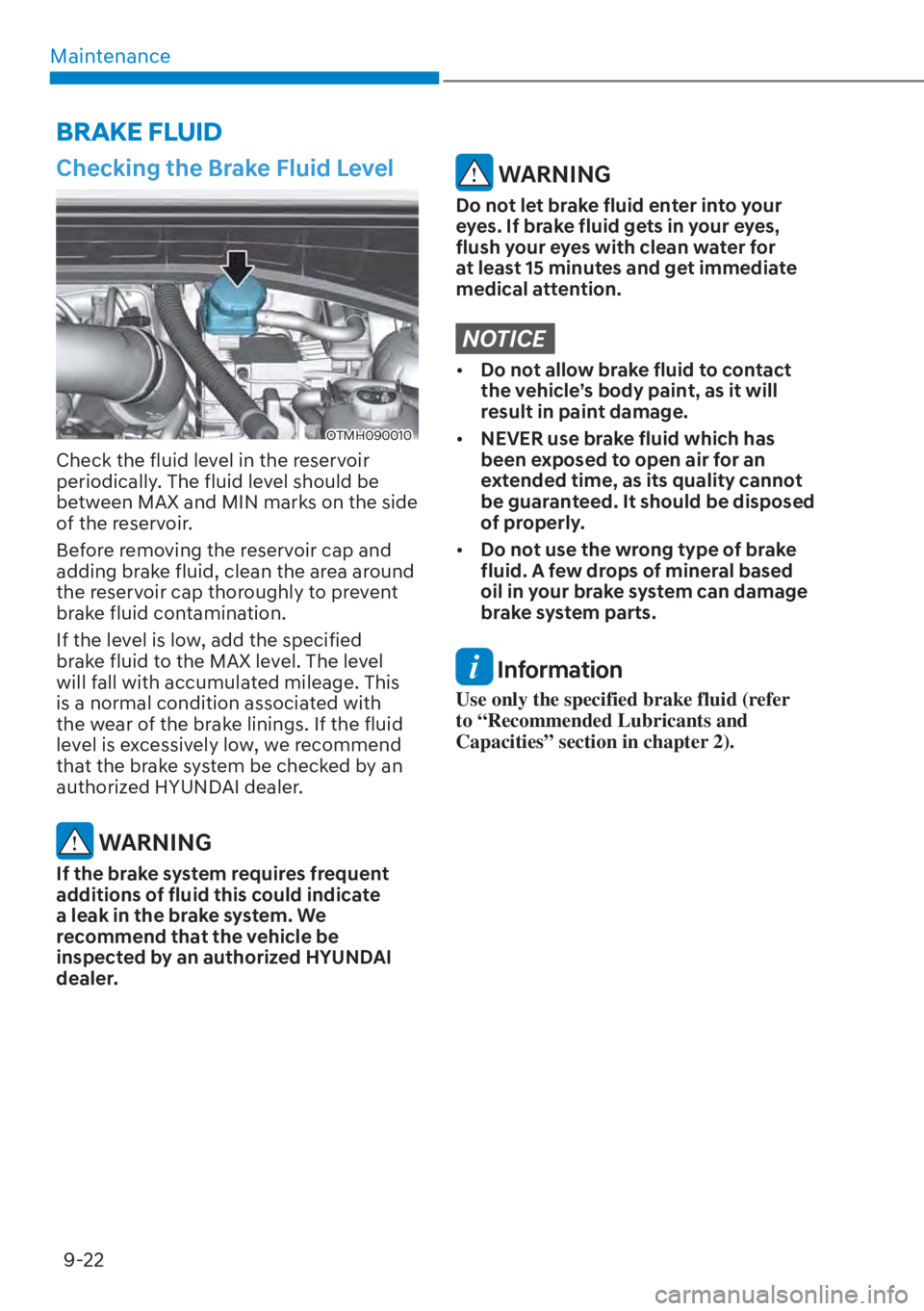Page 41 of 623

Vehicle Information, Consumer Information and Reporting Safety Defects2-12
To help achieve proper engine and powertrain performance and durability, use only
lubricants of the proper quality. The correct lubricants also help promote engine
efficiency that results in improved fuel economy.
These lubricants and fluids are recommended for use in your vehicle.
Lubricant VolumeClassification
Engine oil
*1 *2
(drain and refill) Recommends
���������8�6���T�W���������������b�� SAE 0W-20, API SN PLUS/SP or
ILSAC GF-6
Automatic transmission fluid
���������8�6���T�W�����������b��SK ATF SP4M-1, MICHANG ATF
SP4M-1, S-OIL ATF SP4M-1,
Hyundai Genuine ATF SP4M-1
Coolant �����������8�6���T�W�����������������b��Mixture of antifreeze and water
(Phosphate-based Ethylene glycol
coolant for aluminum radiator)
Inverter Coolant ���������8�6���T�W�����������������b��Mixture of antifreeze and water
(Phosphate-based Ethylene glycol
coolant for aluminum radiator)
Rear differential oil (AWD) 0.56~0.67 US qt.
�����������a�����������b�� HYPOID GEAR OIL API GL-5, SAE
75W/85 (SK HCT-5 GEAR OIL
75W/85 or EQUIVALENT)
Transfer case oil (AWD) 0.65~0.71 US qt.
�����������a�����������b��
Brake fluid
*3As required SAE J1704 DOT-4 LV, FMVSS 116
DOT-4, ISO4925 CLASS-6
Fuel �����������8�6���T�W�������������b��Refer to “Fuel requirements” in
chapter 1.
*1 : Refer to the recommended SAE viscosity numbers on the next page.
*2 : Requires < API SN PLUS (or above) Full synthetic> grade engine oil. If a lower grade
engine oil (mineral oil including Semi-synthetic) is used, then the engine oil and engine
oil filter must be replaced as indicated severe maintenance condition.
*3 : To maintain the best braking performance and ABS/ESC performance, you use genuine
brake fluid that conform to specifications.
*4 : Different type of coolant or water may damage the electrical component.
RECOMMENDED LUBRICANTS AND CAPACITIES
Page 552 of 623

Maintenance9-16
Checking the Engine Oil Level
Engine oil is used for lubricating,
cooling, and operating various hydraulic
components in the engine. Engine oil
consumption while driving is normal,
and it is necessary to check and refill the
engine oil regularly. Also, check and refill
the oil level within the recommended
maintenance schedule to prevent
deterioration of oil performance.
Check the engine oil following the below
procedure.
1. Follow all of the oil manufacturer’s precautions.
2. Be sure the vehicle is on the level ground in P (Park) with the parking
brake set and the wheels blocked.
3. Turn the engine on and warm the engine up until the coolant
temperature reaches a constant
normal temperature.
4. Turn the engine off, remove the oil filler cap and pull the dipstick out.
Wait for 15 minutes for the oil to return
to the oil pan.
5. Wipe the dipstick clean and re-insert it fully.
OTMH090002
6. Pull the dipstick out again and check the level. The level should be between
F (Full) and L (Low).
OTMPH091012N
7. If the oil level is below L, add enough oil to bring the level to F.
Use only the specified engine oil (Refer
to “Recommended Lubricants and
Capacities” section in chapter 2).
NOTICE
To prevent damage to your engine:
�[�� Do not spill engine oil when adding
or changing engine oil. Wipe off
spilled oil immediately.
�[�� The engine oil consumption may
increase while you break in a new
vehicle and it will be stabilized after
driving 4,000 miles (6,000 km).
�[�� The engine oil consumption can be
affected by driving habits, climate
conditions, traffic conditions,
oil quality, etc. Therefore, it is
recommended that you inspect the
engine oil level regularly and refill it
if necessary.
ENGINE OIL
Page 558 of 623

Maintenance9-22
Checking the Brake Fluid Level
OTMH090010
Check the fluid level in the reservoir
periodically. The fluid level should be
between MAX and MIN marks on the side
of the reservoir.
Before removing the reservoir cap and
adding brake fluid, clean the area around
the reservoir cap thoroughly to prevent
brake fluid contamination.
If the level is low, add the specified
brake fluid to the MAX level. The level
will fall with accumulated mileage. This
is a normal condition associated with
the wear of the brake linings. If the fluid
level is excessively low, we recommend
that the brake system be checked by an
authorized HYUNDAI dealer.
WARNING
If the brake system requires frequent
additions of fluid this could indicate
a leak in the brake system. We
recommend that the vehicle be
inspected by an authorized HYUNDAI
dealer.
WARNING
Do not let brake fluid enter into your
eyes. If brake fluid gets in your eyes,
flush your eyes with clean water for
at least 15 minutes and get immediate
medical attention.
NOTICE
�[�� Do not allow brake fluid to contact
the vehicle’s body paint, as it will
result in paint damage.
�[�� NEVER use brake fluid which has
been exposed to open air for an
extended time, as its quality cannot
be guaranteed. It should be disposed
of properly.
�[�� Do not use the wrong type of brake
fluid. A few drops of mineral based
oil in your brake system can damage
brake system parts.
Information
Use only the specified brake fluid (refer
to “Recommended Lubricants and
Capacities” section in chapter 2).
BRAKE FLUID